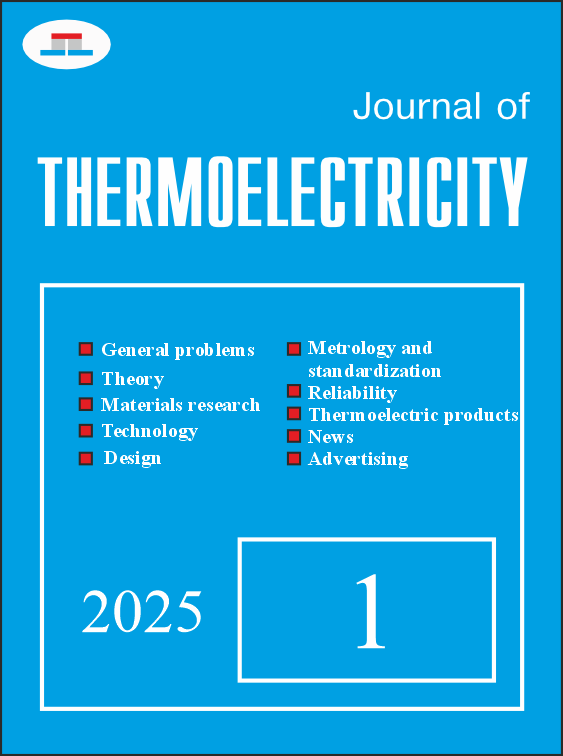Development of Solar Energy Systems Based on High Performance Bulk and Film Thermoelectric Modules
DOI:
https://doi.org/10.63527/1607-8829-2025-1-60-80Keywords:
solar energy, thermoelectric module, figure of merit, film thermoelectric micro-converterAbstract
Due to the increase in energy demand and depletion of natural resources, the development of energy harvesting technologies becomes very important. Thermoelectric devices, based on the direct conversion of heat into electrical energy, are being the essential part of cost-effective, environmental-friendly, and fuel-saving energy sources for power generation, temperature sensors, and thermal management. High reliability and long operation time of thermoelectric energy systems lead to their extensive use in space industry and gas pipe systems. Development and wide application of solar thermoelectric converters (generators) is mainly limited by relatively low thermoelectric conversion efficiency. In this work, we suggest for the first time to use direct conversion of solar energy by systems based on high-performance multistage thermoelectric modules operating in the temperature range of 300 - 900 K for creation of autonomic systems with electric power up to 500 W and electric efficiency up to 15%. Furthermore, we developed film thermoelectric modules on thin flexible substrates with the figure of merit corresponding to that of bulk modules. Such film thermoelectric converters with output voltage of several volts and electric power of several microwatts can be used at solar energy micro-systems
References
1. Zoui, M. A., Bentouba, S., Stocholm, J. G., & Bourouis, M. (2020). A review on thermoelectric generators: Progress and applications. Energies, 13(14), 3606. https://doi.org/10.3390/en13143606
2. Champier, D. (2017). Thermoelectric generators: A review of applications. Energy Conversion and Management, 140, 167–181. https://doi.org/10.1016/j.enconman.2017.02.070
3. Vikhor, L. N., & Anatychuk, L. I. (2009). Generator modules of segmented thermoelements. Energy Conversion and Management, 50(9), 2366–2372. https://doi.org/10.1016/j.enconman.2009.05.014
4. Maslamani, T. M., Omer, A. I., & Majid, M. (2014). Development of solar thermoelectric generator. European Scientific Journal, 10(3), 92–101.
5. Dashevsky, Z., Kaftori, D., & Rabinovich, D. (1998). High efficiency thermoelectric unit within an autonomous solar energy converter. In Seventeenth International Conference on Thermoelectrics. Proceedings ICT98 (Cat. No. 98TH8365) (pp. 531–534). IEEE. https://doi.org/10.1109/ICT.1998.694878
6. Indira, S. S., Vaithilingam, C. A., Chong, K.-K., Saidur, R., Faizal, M., Abubakar, S., & Paiman, S. (2020). A review on various configurations of hybrid concentrator photovoltaic and thermoelectric generator system. Solar Energy, 201, 122–148. https://doi.org/10.1016/j.solener.2020.03.039
7. Field, H. (1997). Solar cell spectral response measurement errors related to spectral band width and chopped light waveform. In Conference Record of the Twenty-Sixth IEEE Photovoltaic Specialists Conference – 1997 (pp. 471–474). IEEE. https://doi.org/10.1109/PVSC.1997.654186
8. Huang, G., Curt, S. R., Wang, K., & Markides, C. N. (2020). Challenges and opportunities for nanomaterials in spectral splitting for high-performance hybrid solar photovoltaic-thermal applications: A review. Nano Materials Science, 2(3), 183–203. https://doi.org/10.1016/j.nanoms.2020.05.001
9. Dashevsky, Z., Jarashneli, A., Unigovski, Y., Dzundza, B., Gao, F., & Shneck, R. Z. (2022). Development of a high performance gas thermoelectric generator (TEG) with possible use of waste heat. Energies, 15(11), 3960. https://doi.org/10.3390/en15113960
10. El Oualid, S., Kosior, F., Dauscher, A., Candolfi, C., Span, G., Mehmedovic, E., Paris, J., & Lenoir, B. (2020). Innovative design of bismuth-telluride-based thermoelectric micro-generators with high output power. Energy & Environmental Science, 13(11), 3579–3591. https://doi.org/10.1039/D0EE01176B
11. He, W., Zhang, G., Zhang, X., Ji, J., Li, G., & Zhao, X. (2013). Recent development and application of thermoelectric generator and cooler. Applied Energy, 143, 1–25. https://doi.org/10.1016/j.apenergy.2014.12.075
12. Shi, X., Zou, J., & Chen, Z.-G. (2020). Advanced thermoelectric design: From materials and structures to devices. Chemical Reviews, 120(15), 7399–7515. https://doi.org/10.1021/acs.chemrev.9b00888
13. Kraemer, D., Poudel, B., Feng, H.-P., Caylor, J. C., Yu, B., Yan, X., Ma, Y., Wang, X., Wang, D., Muto, A., McEnaney, K., Chiesa, M., Christofferson, J. P., et al. (2011). High-performance flat-panel solar thermoelectric generators with high thermal concentration. Nature Materials, 10, 532–538. https://doi.org/10.1038/nmat3013
14. Park, K.-T., Choi, K.-J., & Kim, Y.-S. (2013). Power improvement of a thermoelectric generator by using double stage and optimizing Seebeck coefficient of thermoelectric materials. Current Applied Physics, 13(7), 1391–1395. https://doi.org/10.1016/j.cap.2013.04.007
15. Zebarjadi, M., Esfarjani, K., Dresselhaus, M. S., Ren, Z. F., & Chen, G. (2012). Perspectives on thermoelectrics: From fundamentals to device applications. Energy & Environmental Science, 5(1), 5147–5162. https://doi.org/10.1039/C1EE02497C
16. Anuar, A., Zaidi, S. H., Amer, N. H., Azmi, W. H., Sopian, K., & Yatim, B. (2020). A review on thermoelectric renewable energy: Principle, application and scope. International Journal of Renewable Energy Research, 10(1), 164–172.
17. Wang, L., Yu, T., He, Y., Zhang, H., & Wang, Y. (2016). Experimental and simulation study on a concentrating photovoltaic/thermoelectric hybrid system. Solar Energy, 132, 187–197. https://doi.org/10.1016/j.solener.2016.03.032
18. Caillat, T., Borshchevsky, A., & Fleurial, J.-P. (1997). Properties of single crystalline semiconducting CoSb₃. Journal of Applied Physics, 80(8), 4442–4449. https://doi.org/10.1063/1.363403
19. Al-Ameen, A., & Sharma, R. K. (2016). Thermoelectric materials and devices: A review of recent progress. Journal of Electronic Materials, 45(11), 5551–5560. https://doi.org/10.1007/s11664-016-4721-1
20. Hung, N. N., Hung, L. H., Linh, V. T., & Hanh, P. T. M. (2019). Fabrication and thermoelectric properties of Bi₂Te₃-based materials. Materials Science Forum, 961, 179–185. https://doi.org/10.4028/www.scientific.net/MSF.961.179
21. Alam, H., & Ramakrishna, S. (2013). A review on the enhancement of figure of merit from bulk to nano-thermoelectric materials. Nano Energy, 2(2), 190–212. https://doi.org/10.1016/j.nanoen.2012.10.005
22. Goldsmid, H. J. (2010). Introduction to thermoelectricity. Springer. https://doi.org/10.1007/978-3-642-00716-3
23. Rowe, D. M. (2006). Thermoelectrics handbook: Macro to nano. CRC Press.
24. He, W., Zhang, G., Zhang, X., Liu, J., & Shi, B. (2011). Experimental study on thermoelectric generator using exhaust gas of automobiles. Energy Conversion and Management, 52(1), 73–78. https://doi.org/10.1016/j.enconman.2010.06.059
25. Venkatasubramanian, R., Siivola, E., Colpitts, T., & O’Quinn, B. (2001). Thin-film thermoelectric devices with high room-temperature figures of merit. Nature, 413(6856), 597–602. https://doi.org/10.1038/35098012
26. Bell, L. E. (2008). Cooling, heating, generating power, and recovering waste heat with thermoelectric systems. Science, 321(5895), 1457–1461. https://doi.org/10.1126/science.1158899
27. Sales, B. C. (2003). Critical overview of recent approaches to improved thermoelectric materials. MRS Bulletin, 28(1), 15–20. https://doi.org/10.1557/mrs2003.4
28. Dresselhaus, M. S., Chen, G., Tang, M. Y., Yang, R. G., Lee, H., Wang, D. Z., Ren, Z., Fleurial, J. P., & Gogna, P. (2007). New directions for low-dimensional thermoelectric materials. Advanced Materials, 19(8), 1043–1053. https://doi.org/10.1002/adma.200600527
29. Heremans, J. P., Thrush, C. M., & Morelli, D. T. (2004). Thermopower enhancement in lead telluride nanostructures. Physical Review B, 70(11), 115334. https://doi.org/10.1103/PhysRevB.70.115334
30. Lin, Y.-M., & Dresselhaus, M. S. (2003). Thermoelectric properties of superlattice nanowires. Physical Review B, 68(7), 075304. https://doi.org/10.1103/PhysRevB.68.075304
31. Poudel, B., Hao, Q., Ma, Y., Lan, Y., Minnich, A., Yu, B., Yan, X., Wang, D., Muto, A., Vashaee, D., Chen, X., Liu, J., Dresselhaus, M. S., Chen, G., & Ren, Z. (2008). High-thermoelectric performance of nanostructured bismuth antimony telluride bulk alloys. Science, 320(5876), 634–638. https://doi.org/10.1126/science.1156446
32. Tritt, T. M., & Subramanian, M. A. (2006). Thermoelectric materials, phenomena, and applications: A bird’s eye view. MRS Bulletin, 31(3), 188–198. https://doi.org/10.1557/mrs2006.44
33. Ohta, H., Kim, S. W., Mune, Y., Mizoguchi, T., Nomura, K., Ohta, S., Nomura, T., Nakanishi, Y., Ikuhara, Y., & Koumoto, K. (2007). Giant thermoelectric Seebeck coefficient of a two-dimensional electron gas in SrTiO₃. Nature Materials, 6, 129–134. https://doi.org/10.1038/nmat1821
34. Minnich, A. J., Dresselhaus, M. S., Ren, Z. F., & Chen, G. (2009). Bulk nanostructured thermoelectric materials: Current research and future prospects. Energy & Environmental Science, 2(5), 466–479. https://doi.org/10.1039/B822664B
35. Snyder, G. J., & Toberer, E. S. (2008). Complex thermoelectric materials. Nature Materials, 7(2), 105–114. https://doi.org/10.1038/nmat2090
36. Harman, T. C., Taylor, P. J., Walsh, M. P., & LaForge, B. E. (2002). Quantum dot superlattice thermoelectric materials and devices. Science, 297(5590), 2229–2232. https://doi.org/10.1126/science.1072886
37. Harman, T. C., & Honig, J. M. (1967). Thermoelectric and thermomagnetic effects and applications. McGraw-Hill.
38. Lin, S., Li, W., Zhang, X., Chen, Z., Shen, J., Zheng, Y., Witting, I. T., Kim, H., Gao, C., & Chen, Y. (2021). High thermoelectric performance of copper sulfide-based materials. Nature Communications, 12(1), 1–9. https://doi.org/10.1038/s41467-021-21058-3
39. Huang, X., Deng, Y., Xu, C., Zhou, Y., Yang, L., & Zhang, Y. (2019). Recent advances in thermoelectric materials and devices based on carbon nanotubes. Composites Part A: Applied Science and Manufacturing, 124, 105504. https://doi.org/10.1016/j.compositesa.2019.105504
40. Zeng, X., Xia, Y., Yang, Y., Zhang, H., & Liu, Y. (2020). Flexible thermoelectric materials and generators: Challenges and innovations. Advanced Energy Materials, 10(20), 1902733. https://doi.org/10.1002/aenm.201902733
41. Li, D., Xu, W., Fan, P., Cai, B., Wang, Y., & Zhou, X. (2020). Enhanced thermoelectric performance of carbon nanotube-based flexible composites by incorporating silver nanowires. ACS Applied Materials & Interfaces, 12(11), 13147–13155. https://doi.org/10.1021/acsami.9b22127
42. Zheng, Z. H., Xie, Y. B., Li, L. H., Wang, X. D., Jiang, L., & Hu, P. (2021). Recent progress on wearable thermoelectric devices: Materials, structures and applications. Nano Energy, 81, 105734. https://doi.org/10.1016/j.nanoen.2020.105734
43. Zhang, Q., Sun, Y., Xu, W., & Zhu, D. (2014). Organic thermoelectric materials: Emerging green energy materials converting heat to electricity directly and efficiently. Advanced Materials, 26(40), 6829–6851. https://doi.org/10.1002/adma.201306060
44. Kim, G.-H., Shao, L., Zhang, K., & Pipe, K. P. (2013). Engineered doping of organic semiconductors for enhanced thermoelectric efficiency. Nature Materials, 12(8), 719–723. https://doi.org/10.1038/nmat3635
45. Wang, H., Hsu, W.-T., & Yang, J. (2016). Flexible thermoelectric materials and devices. In R. Prasher & K. Koumoto (Eds.), Thermoelectric energy conversion (pp. 213–250). Woodhead Publishing. https://doi.org/10.1016/B978-1-78242-458-1.00009-3
46. Zhu, T., Liu, Y., Fu, C., Heremans, J. P., Snyder, G. J., & Zhao, X. (2021). Compromise and synergy in high-efficiency thermoelectric materials. Advanced Materials, 33(28), 2100185. https://doi.org/10.1002/adma.202100185
47. Tang, Y., Gibbs, Z. M., Agapito, L. A., Li, G., Kim, H.-S., Nardelli, M. B., Curtarolo, S., & Snyder, G. J. (2015). Convergence of electronic bands for high performance bulk thermoelectrics. Nature Materials, 14(12), 1223–1228. https://doi.org/10.1038/nmat4437
48. Zhao, L. D., Dravid, V. P., & Kanatzidis, M. G. (2014). The panoscopic approach to high performance thermoelectrics. Energy & Environmental Science, 7(1), 251–268. https://doi.org/10.1039/C3EE43099E
49. Snyder, G. J., & Ursell, T. S. (2003). Thermoelectric efficiency and compatibility. Physical Review Letters, 91(14), 148301. https://doi.org/10.1103/PhysRevLett.91.148301
50. Zebarjadi, M. (2016). Electronic thermal conductivity. Materials Today Physics, 3, 1–5. https://doi.org/10.1016/j.mtphys.2017.09.002
51. Zhou, M., Chen, G., & Dresselhaus, M. S. (2015). Thermoelectric materials: Energy conversion between heat and electricity. Journal of Physics: Condensed Matter, 27(48), 483001. https://doi.org/10.1088/0953-8984/27/48/483001
52. Vineis, C. J., Shakouri, A., Majumdar, A., & Kanatzidis, M. G. (2010). Nanostructured thermoelectrics: Big efficiency gains from small features. Advanced Materials, 22(36), 3970–3980. https://doi.org/10.1002/adma.201000839




